|
New York Architecture Images-New York Architects Ernest Flagg (1857–1947) |
||||
| New York works; | ||||
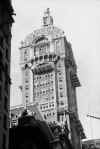
|
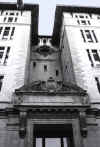
|
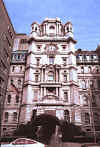 |
||
| 003 Singer Building | 017 |
011 Saints Luke's Hospital Amsterdam Wing | ||

|
 |
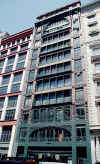
|
||
| 047
Scribner’s Bookstore |
001 The Little Singer Building | |||
| Ernest Flagg studied architecture at the École des Beaux-Arts and was one of the few Americans who returned from Paris with an interest in and understanding of French architectural theory. Flagg's practice was limited, in part by his obnoxious personality, but he had a few loyal clients (including several relatives) and designed some of the most important residential, institutional, and commercial buildings at the turn of the twentieth century in New York. He designed homes and stores for the Scribner book publishing family (his wife was a Scribner) and was a favorite architect of the Clark family, which was involved with the Singer Sewing Machine Company. Flagg's most famous building was the Singer Tower (1908) on Broadway (demolished), carefully planned to be the world's tallest building. Flagg was also involved in tenement reform and designed a series of model apartment houses and single-family dwellings. | ||||
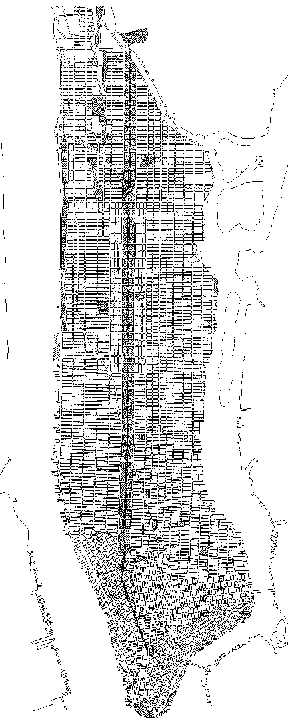
|
||||
|
THE PLAN OF NEW YORK, AND HOW TO IMPROVE IT Ernest Flagg Scribner's Magazine 36 (August 1904): 253-56. Flagg (1857-1947) practiced architecture in New York from 1891 following the completion of his studies in Paris at the Ecole des Beaux Arts. One of his earliest commissions was the design of St. Luke's Hospital and marked Flagg's first great success. He was among those who championed the "modern" French school of architecture--what we know as the beaux-arts style. Flagg's major buildings include the Singer and the Scribner Buildings in New York, the Naval Academy in Annapolis, the Washington State capitol at Olympia, and the Corcoran Gallery in Washington. His practice was international as well, with building commissions executed in St. Petersburg and Budapest. As a native of Brooklyn and a resident of New York, he took a special interest in the problems of the city. His proposal in this essay to create an extremely wide mall-like thoroughfare cutting through and destroying Central Park apparently attracted little support. His critique of the 1811 plan for Manhattan, however, probably reflected the thoughts of most architects and city planners of the time. Probably no more important plan was ever made at a single stroke than that for the laying out of the upper part of the City of New York, adopted early in the last century, and since then adhered to with a fidelity worthy of a better result. This plan has governed in the expenditure of untold wealth; it has probably had as much to do as any other one thing in shaping the character, habits and customs of the people, for it has fixed their environment; it has lain like a huge gridiron on the city, binding it to hopeless monotony and humdrum commercialism of aspect, and acting as a barrier to any attempt to impart to the town that grand metropolitan air which distinguishes most of the great capitals of Europe. If the planners had only followed the simplest dictates of common prudence and provided a broad open strip along each water front, and another through the centre of the island to insure ample means of transit, the other failings of their plan might have been forgiven; for even with this much--so great are the natural advantages of the site--New York could have become one of the most beautiful and commodious cities on earth. It is easy enough now, as we look at the plan, to follow the narrow working of the minds of the planners. To them the great city of the future was to be simply an enlargement of the primitive town of their own day. Their horizon was bounded entirely by what they saw before them, and their one desire seems to have been to make use of every available square foot of land for strictly utilitarian purposes. The side streets were to afford quiet places of residence, and the avenues the necessary means of communication longitudinally. With this one idea in mind, everything else was easy; the natural topography of the island was disregarded; streets were laid out over watercourse, swamp and hill, with mathematical regularity. The first requisites of a great metropolis for other things than streets and lots seem not to have been considered. Of artistic effect there was not a suggestion; the thought of such a thing probably never entered the heads of the planners. Their ideas were narrow and provincial, and their plan reflected and has retained their ideals. With such a plan, is it surprising that the city should be noted for its lack of civic pride? So little did the makers of the plan foresee the enormous pressure which would be brought upon the longitudinal means of transit when the city should be built up, by the daily ebb and flow of the vast population for which lots were provided, that only one avenue running north and south was laid out in a given distance to four tran[s]verse streets. Moreover, most of these avenues were arranged so as to be of the least possible use. They start from nowhere in particular, for they were joined on to the old street system arbitrarily wherever they happened to come, and no attempt was made to bring the old plan into harmony with the new. The only serviceable through lines for traffic were those which already existed--the Bowery and its extension, Third Avenue, and Broadway joined to the old Bloomingdale Road. The result has been that the main flow of traffic has been congested into these streets. The avenues which are crossed by Broadway have never received anything like their proportionate development below the points of crossing. The lower parts of Fifth, Sixth and Seventh Avenues are dead ends, so to speak; they serve little purpose in relieving the stress of up and down traffic. To make them serviceable they need a feeder of sufficient magnitude at their lower ends, which could be had by enlarging Varick Street, in a somewhat more radical way than that recently suggested by the Municipal Art Society, viz., by cutting it through to meet Broadway at the City Hall at one end, to intersect Bleecker Street at the other end, making it of great width and extending the avenues to meet it. Broadway would then be relieved at its most congested point, and the whole lower west side would receive its proper development. If this change were made, even at the great cost it would now involve, the increased taxes based on the rise in value of the region benefitted would undoubtedly soon more than cover the interest on the sum expended. The efforts which have heretofore been made to break the bond imposed on the city by the adoption of the unfortunate plan of 1807 have been so restricted or hampered by existing conditions, and have been carried out with so little method and continuity of purpose, that they have amounted to scarcely more than makeshifts. From time to time a square has been opened here, a park there, a street cut through in one place or widened in another, but these improvements have been entirely local in their effect, and have failed to change the general appearance of the city. Even the greatest of all these changes, the laying out of Central Park, was unfortunate, to say the least, for it serves to aggravate one of the worst features of the original plan, viz., the failure to provide a central artery of communication worthy of the coming city. If it was an error to provide four transverse streets in a given distance to one longitudinal one for a city in which the main flow of travel must always be up and down, what can be said for an improvement which practically closed the two central avenues, and placed the park on the natural axis of traffic? Perhaps it is not yet time for the full magnitude of this mistake to be generally understood. Central Park is still regarded by most New Yorkers with pride; and rightly so, for it is beautiful, and up to the present time has served its purpose well; but the time must soon come when the disadvantages of its location will be too apparent to be hid. If one examines the present situation without prejudice, he must admit that the raison d 'etre for the park as it stands is becoming daily less and less apparent. In its laying out and treatment Central Park is essentially a suburban pleasure ground. Its scenery is naturalistic; its lakes, groves, and meadows are intended to represent a bit of beautiful rural landscape. Before tall buildings began to surround it, it fulfilled this function fairly well; the illusion was complete enough to be satisfying; but now to some extent the charm is lost by the intruding buildings, and in the future, when completely surrounded by them, it will be almost entirely lost. It will then cease to be a rural pleasure ground, and become simply the affectation of one, in the heart of a large city, where every requirement of common sense and good taste calls for a different kind of treatment. Ornamental grounds of this sort should not be so wide as to be inconvenient and serve as a barrier between the adjacent parts of the city as Central Park does. They should be laid out in a formal rather than a naturalistic way, for as they must be seen in connection with the buildings, there should be such a degree of harmony between the two that the one may play into the hands of the other. The grounds should form a beautiful foil or setting for the buildings, and the buildings serve to ornament the grounds. The purpose of such pleasure grounds should be to open up and enliven the appearance of the city, to bring sunlight, air, and verdure into the heart of the town; to afford agreeable promenades and drives; and by a judicious choice of location to distribute these benefits within the reach of the greatest possible number of people. Since Central Park was laid out conditions have changed; with the completion of the proposed lines of rapid transit, the real suburbs will become as accessible to the mass of the population of the future as the park has been in the past. What is needed now is, not a suburban central park, but agreeable ways to reach the suburban park system for which provision has fortunately been made. The reservoirs which occupy so much of the park area are no longer needed where they are. Formerly, when the entire water supply depended on the High Bridge Aqueduct, it was necessary to have a considerable storage capacity on the island; but now, when there can be any number of subterranean conduits, the reason for it has ceased to exist. It is not pretended for a moment that the densely populated part of the city requires fewer breathing spaces than it now has; on the contrary it needs more, and a better distribution of them. The few open squares scattered about the town are utterly inadequate. As now arranged they serve rather to remind one of the general lack of verdure than to supply its want. The few trees which they possess are a poor substitute for the wooded avenues one finds in other great cities. There is a crying need here for long stretches of grass, avenues of trees, and gardens, so placed that they can be conveniently reached by all the people; and the shape of this island is such that if there were a parkway through its centre, this want might be fulfilled. New York ought to have such an avenue like the Champs Elysées of Paris, Unter den Linden of Berlin, or the Ring Strasse of Vienna, but more ample than any of them; for here, of all places, owing to the shape of the island, there is the most need of such a thing. Fortunately this can be had now, if we want it, without either bankrupting the treasury or curtailing the habitable area of the town. To obtain the funds, it would only be necessary to sell off land which the city now owns, and apply the proceeds to the purchase of other land of at least equal extent. If those parts of the park lying between Fifth Avenue and the extension of Sixth Avenue on the east side and between Eighth Avenue and the extension of Seventh Avenue on the west side, were sold, and the proceeds applied to the purchase of all the land lying between Sixth and Seventh Avenues, from Christopher Street to the Harlem River, the city would then have a strip for a park thousand feet wide and more than ten miles long, lying right on the central axis of the city, where it would do the most good to the greatest number of inhabitants. Here could be constructed a thoroughfare worthy of the metropolis of the new world. If opened up at the lower end by a suitable avenue of approach from the City Hall Park, such as already suggested by way of an enlarged Varick Street, and connected with the district beyond the Harlem River by the necessary bridges, it would solve the difficulties of through transit for the city for all time, become the finest, as it would be the most important, highway of the world, and at the same time give to the entire island the breathing space and beauty it now so sorely needs. Some idea of the splendor of such a plan may be had when we realize that even if the central avenue or parkway had a clear roadway 160 feet wide, or four times the width of that of Fifth Avenue, there would still remain for gardens distributed on both sides of it a space about as wide as Madison Square is long. Now imagine this strip of verdure extended for ten miles through the heart of the town, shaded by trees, ornamented with shrubbery, fountains, statuary, arches, and every other suitable embellishment, and where could one find its equal? The finest of avenues of the old world would pale in comparison. The Mall at Washington as it is proposed to rearrange it would not be as wide and only about one-fifth as long. Such a programme of course could not be carried out at once without involving unnecessary expense and great inconvenience, but it might be done gradually. If improvements were stopped on the area to be acquired, the city could easily undertake the conversion of one or two blocks a year, at the same time selling off an equal area of its park lands. If this were done systematically, in the course of forty or fifty years the task would be accomplished without great disturbance of values, with little inconvenience, and at comparatively slight cost. |
||||
|
links |
||||